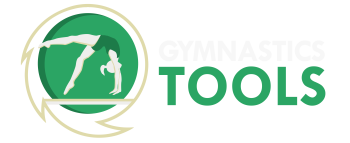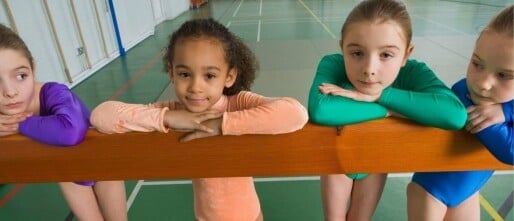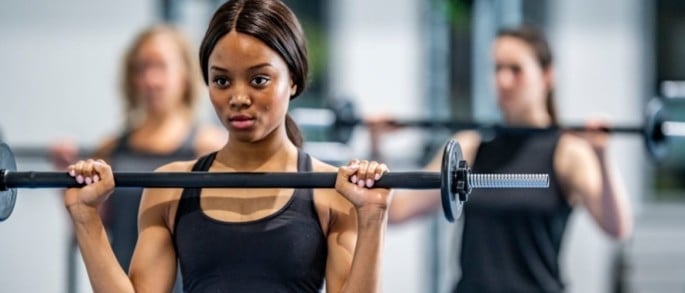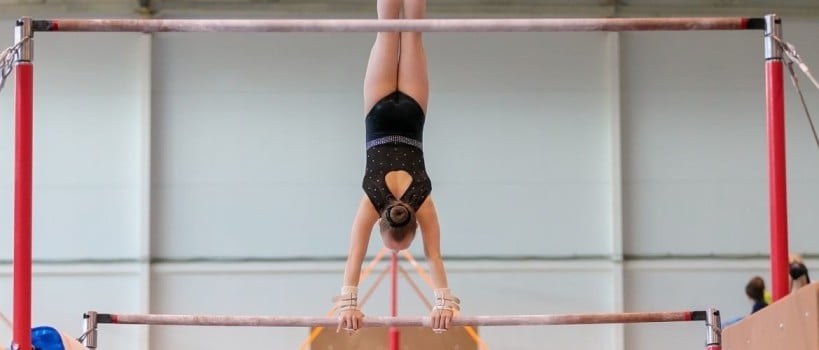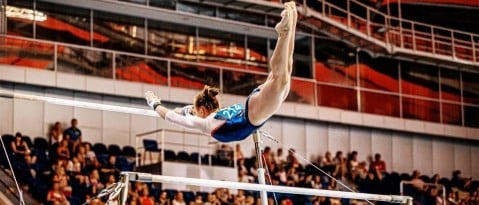Coordination plays a very big role in gymnastics. For example, your body must know where it is in space when you make a screw. You have to start the rotation at exactly the right moment and then know when to start the landing. Another example is the wipper on the bridge. For example, you start the sole turn and then, at exactly the right moment, you have to spread your legs and jump to the high bar.
Your body knows exactly where your hands should be in relation to the stick so that you can grasp it and continue your exercise. And all this in just a few seconds. Fascinating, such a body, isn’t it? In this article, we will go through examples of coordination training for floor, vault, bar and beam.
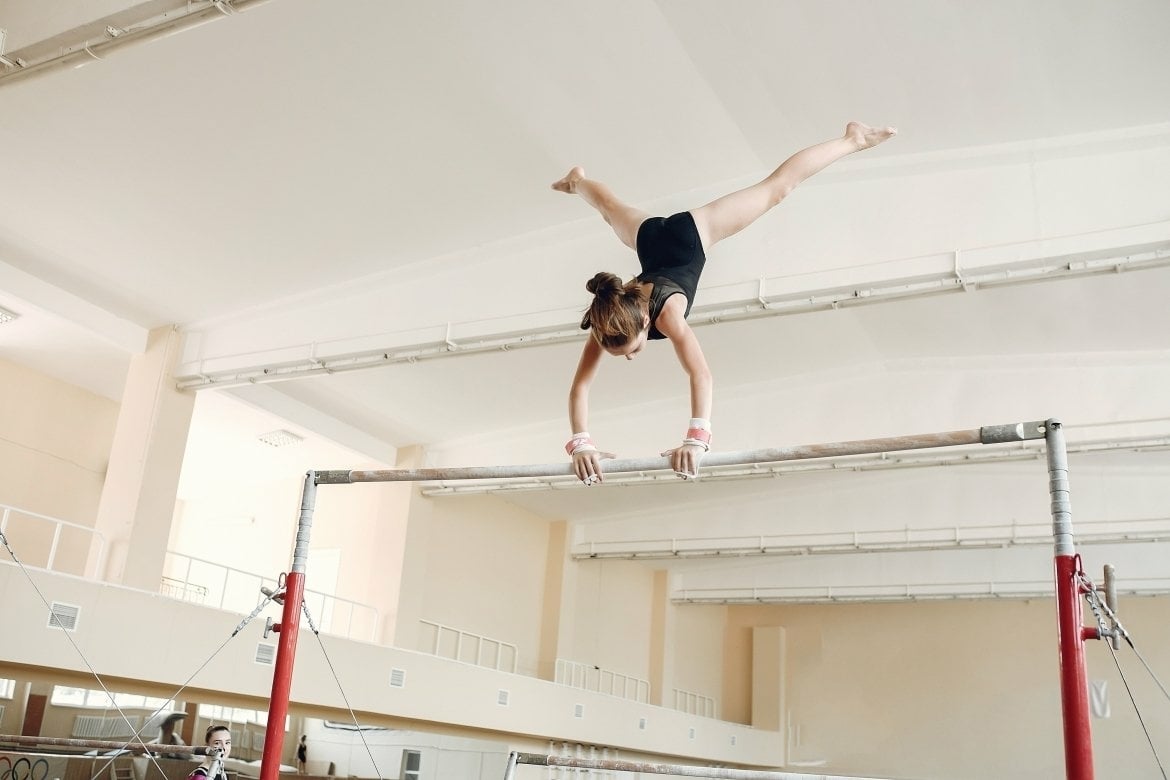
The definition of coordination
Coordination is the cooperation of the motor system (e.g. the muscles) and the balance organ. An important part of this is proprioception. Propriocepsis literally means ”sense of position”; the awareness of your body in space.
Proper coordination ensures balance. Systems involved in balance are:
- Visual system
- Nervous system (somato-sensory system)
- Balance organ
Coordination on the floor
Example 1: screw training
In the following screw exercises, the goal is to land on your belly or back. Your body must know where it is in space in order to land on your stomach after half a turn. With good coordination, you land on the mattress in the right way. If you turn too slowly, for example, you land on your side instead of on your stomach.
Example 2: Ladder training
Choose, for example, a walking ladder training in the warm-up. Choose running and jumping forms. This requires the core, legs and ankles to work together closely in order to turn, twist and jump quickly.
Examples are:
- tripping forwards, sideways and backwards and combinations thereof
- handball jumps
- gait with blocked gaiter boxes: you are not allowed to stand in them
Fun variations of running and jumping training are also available:
Jumping from hoop to hoop.
The gymnast must have the right coordination to land and jump through the hoop. For younger gymnasts this is a good external focus.
You can choose different jump variants including spread-eagle jumps, squat jumps, half-turn jumps, etc.
Example 3: pirouette training
Draw a circle on the floor and divide it into four quadrants. The aim of this exercise is to get the gymnast to consciously perform quarter, half and full pirouettes (or other variations). You can vary the type of pirouette.
You can do the same with jump variants.
Jump
Coordination parts in jump are:
- jumping correctly into the plank, plankoline or trampoline after your run
- the correct hand placement on the pegasus
- the landing
In the video below, the gymnast is asked to perform various coordination actions. First the gymnast has to jump over the hoop with a push-off, then she has to place her hands correctly over the blocks and finally land on the landing mat.
What I do as a coach for jump situations is to draw spots with magnesium on the board, pegasus and landing spot. A gymnast can then focus on the crosses where she should place her hands and feet. This is a nice external focus to train coordination.
A coordination exercise for making handball jumps on different surfaces is
Balk
Staying on the beam while performing all those tricky gymnastics elements is a coordination training in itself. You have to know exactly where to place your foot after making a running jump. A pirouette, too, requires a lot of judgement. When are you completely round and can you put your foot back on the beam? That is precisely what you have to be able to coordinate well.
Nice coordination exercises with external focus are:
One of my favourite exercises on the beam is skipping rope. It is a super effective exercise that you can easily incorporate into the warm-up, for example. Because jumping rope is something we all used to do in the schoolyard. So why not on the beam 😉 ?
Nice variations are:
- jump backwards
- jump parallel to the beam
- jumping on one leg
- jumping forward
- dribbling jumping rope
- the extra difficult variant: jumping with the eyes closed
Bridge
The bridge demands a lot from the arm and hand coordination. You have to have just the right timing to catch the high leg as you jump across. You also have to know where the high bar is in the room.
Example 1: taking the stick
Example 2: concave-sphere coordination
Hollow-sphere coordination is very important in a giant. This is one of the components of basic form tension. You have to make the hollow-sphere action from the chest at the right moment to round the giant.
Example 3: Opening-close shoulder angle coordination
Opening the shoulder angle in a Loosening Up requires precision. To train this with an external focus, you can ask the gymnast to land on the board. To do this, she must open her shoulder in time.
In the last part of the kip, you should quickly close the arm-shoulder angle.
Example 4: Landing coordination
An easy example is the landing of a put-away somersault. Try to get the gymnast to land on a specific spot by drawing a cross, for example.
Example 5: hand placement
Hand placement is also an important element on the bridge. Nice coordination exercises for this are:
Choose variations in coordination training from landing on different surfaces or turning off the visual system such as closing the eyes. Hopefully this blog has inspired you to consciously incorporate coordination exercises into your training.
Other coordination exercises
A very fun and educational way to train coordination is with reaction training lights. These coloured lights contain special motion sensors. The lights can be hung up with velcro, and this allows for an endless variety of training exercises. In addition to strength, condition and balance, this also certainly improves the coordination of gymnasts.
What do you choose as coordination exercises for your gymnastics class? Let us know in the comments, or talk to other coaches on the coach platform!
Also check our workouts on our Youtube channel. Or check out all the exercises on the gymnastics platform.
